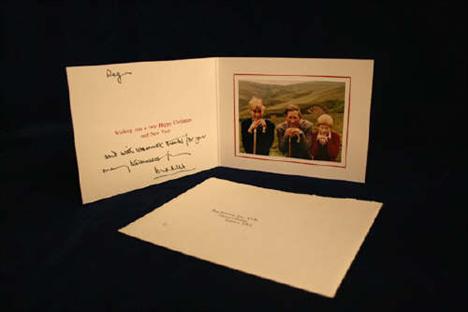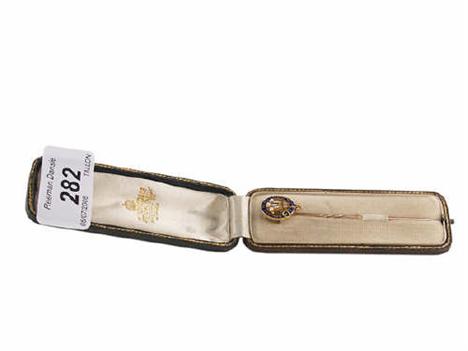We found 122897 price guide item(s) matching your search
There are 122897 lots that match your search criteria. Subscribe now to get instant access to the full price guide service.
Click here to subscribe- List
- Grid
-
122897 item(s)/page
A Collection of Victorian & later jewellery, to include: A 9ct gold cased open face pocket watch, with a yellow metal flat curb link chain; A ladies 9ct gold cased wristwatch by 'Universal Geneve'; An Edwardian 9ct gold bar brooch and a another yellow metal rope twist bar brooch; a silver bar brooch in the form of three hounds heads; 3x misc bangles; a paste set stick pin; a pair 9ct gold domed earrings; another pair yellow metal pendant earrings; a 9ct gold curb link bracelet and another gold chain. (a lot)
A collection of blanc de chine cherub figurines, comprising of cherub holding up a pineapple shaped vase, on rococo base, together with cherub seated at base of candle stick; a pair of cherub salts and a comport, cherub carrying the wavy bowl decorated with flowers and foliage; etc, vase 32 cm high, (11), (a/f).
A white metal toddy spoon, 19th century, together with a silver candle snuffer, London, marks rubbed, a continental white metal twin handled tray and a quantity of silver plated items to include a tea caddy, wine coasters, jug, dish, candle stick; a quantity of costume jewellery to include bar brooch's, silver circular brooch, belt buckle, tie pin, bracelet and necklace, (a lot).
A collection of six 19th century and later walking sticks Ivory topped cane, commemorating I. Jones, 10th January 1807 Brass weed killing wand/stick Mountain Stick Stick with ebonised shaft, horn handle and silver collar Wooden stick with silver collar, Birmingham 1912 Rosewood walking stick
A well-documented and exceptional Second World War immediate D.S.O., two tour D.F.C. group of eight awarded to Squadron Leader J. B. Starky, Royal Air Force, late Royal New Zealand Air Force: in what was undoubtedly one of the great ‘epics ‘of the last war, he flew home his crippled Lancaster after two crew had baled out and two others lay seriously wounded - but Starky was no stranger to perilous flight, having already survived a crash-landing in the desert and coaxed back another Lancaster minus six feet of its starboard wing Distinguished Service Order, G.VI.R., 1st issue, silver-gilt and enamels, the reverse of the suspension bar undated, an official replacement in its Garrard, London case of issue; Distinguished Flying Cross, G.VI.R., reverse officially dated ‘1943’, an official replacement in its Royal Mint case of issue; 1939-45 Star; Air Crew Europe Star; Africa Star; Defence and War Medals, M.I.D. oak leaf; New Zealand War Service Medal 1939-45, the first two virtually as issued, the remainder very fine or better (8) £2500-3000 D.S.O. London Gazette 28 September 1943. The original recommendation states: ‘At 20.11 hours on the night of 5-6 September 1943, Lancaster Y-DS 682 took off for Mannheim. The Captain, Acting Squadron Leader J. B. Starky, was on his forty-seventh trip; the remainder of the crew had about 20 sorties each to their credit. At 01.50 hours the aircraft, with starboard elevator almost completely shot away, the Navigator and Wireless Operator missing, and two more of the crew wounded, forced landed successfully at Ford. What follows is the story of events in between: The trip was uneventful until some 20 miles short of the target. The weather was clear and the aircraft was flying at 19,000 feet. Suddenly without any previous warning, a night fighter dived in a head-on attack. Our aircraft was badly hit, the cockpit was filled with smoke and a bright light gave the impression of a fire. It then went into a violent spiral - the central column rocking violently - and being unable to regain control the Captain gave the order to abandon by parachute. The Mid-Upper Gunner, Sergeant K. Tugwell, called out that the Rear-Gunner was stuck in his turret and the Captain made a desperate effort to regain control. The stick became a little easier, due to the dinghy which had been jammed in the tail unit blowing free, and the Captain regained control. The night fighter - a Ju. 88 - then attacked again from the rear. Both tail and Mid-Upper Gunners held their fire, and shot it down in flames. Squadron Leader Starky then attempted to take stock. He found that both Wireless Operator and Navigator had jumped by parachute, that his Flight Engineer was wounded in the shoulder and the 2nd Pilot wounded in the arm and head. The Bomb Aimer, Flying Officer B. A. W. Beer, had attempted to jump from the front exit, but had been unable to jettison the escape hatch. When he was finally half way out of the aircraft, he heard the Captain say ‘Hold on! ‘as he had the aircraft back under control. The Rear-Gunner was now manning the mid-upper turret, while the Mid-Upper Gunner and Bomb Aimer attended the wounded. The Captain then attempted the most difficult task of bringing his badly damaged aircraft back to base without the assistance of a Wireless Operator or Navigator. He set an approachable course for base and carried on this for over 30 minutes. By this time the Bomb Aimer had gone back to do the navigation, but as the navigators log had gone he had no plot and gave the Captain an amended course for base. On their way across France they were repeatedly fired at by A.A. batteries and as his inter-com had now gone, the Captain was compelled to take evasive action only from the judgment of the gun flashes. On one occasion the Bomb Aimer had to go through to tell the Captain that shells were bursting dangerously near the tail. In this precarious state the damaged Lancaster made its way back through the enemy fighter belt. The Mid-Upper Gunner manned the wireless set and succeeded in getting acknowledgment to a laborious S.O.S. The Bomb Aimer tried unsuccessfully to work GEE. Eventually the Channel was reached and as they drew near the coast the Captain and Bomb Aimer flashed S.O.S. on their lights. As they crossed the shore an immediate green was received and Squadron Leader Starky effected a masterly landing of his now uncontrollable aircraft, bringing it in at an air speed of 140 m.p.h. The story of this flight is an epic, and the return of the aircraft to this country must be considered due firstly and primarily to the superb airmanship and captaincy of Squadron Leader Starky, and actually to the magnificent co-operation of the rest of the crew. Squadron Leader Starky has already been recommended for the Distinguished Flying Cross for his really magnificent work during two tours of operations, and I consider that his latest achievement is worthy of the immediate award of the Distiguished Service Order.’ D.F.C. London Gazette 10 September 1943. The original recommendation states: ‘This officer is now on a second tour of operations. In 1941-42 he carried out a most successful tour on Wellingtons in the U.K. against targets in Germany and German occupied Europe - finishing in the Middle East with attacks against objectives in the Mediterranean. Flight Lieutenant Starky has now completed 42 sorties and has attacked many highly defended targets, including Essen, Benghazi and Pireaus, and has recently been actively engaged in the Battle of the Ruhr. On one occasion recently he collided with another aircraft over enemy territory and lost a large piece of his starboard wing, but succeeded by superb airmanship in bringing his badly damaged aircraft back to base. This officer has at all times shown resolution, courage and ability of the highest order in his attacks on enemy targets. His cheerful contempt for danger and his keenness for operational flying, have set a fine example to the other aircrew of this squadron.’ Mention in despatches London Gazette 11 June 1942. James Bayntun ‘Jim ‘Starky, who was born in Gisborne, New Zealand in November 1916, enlisted in the Royal New Zealand Air Force in July 1940 and commenced pilot training at No. 1 E.F.T.S., Taieri, near Dunedin that August. Following further training at Wigram, Christchurch, he was embarked for the U.K., where he attended No. 20 O.T.U. at Lossiemouth in Scotland and converted to Wellingtons prior to going operational as a 2nd Pilot in No. 149 Squadron at Mildenhall, Suffolk in June 1941. Quickly participating in nine operational sorties over the next few weeks, Dusseldorf, Bremen, Essen, Mannheim and Munster among the chosen targets, in addition to a brace of trips to Brest to attack the Prinz Eugen and Scharnhorst, he was ordered to the Middle East in September 1941, the same month in which he was appointed Flight Sergeant. Posted to No. 148 Squadron on his arrival - another Wellington unit, operating out of Kabrit - his aircraft was hit by flak on his very first sortie to Benghazi on 5 November. Appointed 1st Pilot in the same month, he had his work cut out for him on the night of the 25th while en route to another target, for local Arabs had exchanged a landing ground’s fuel supply for water - his engines cut out shortly after take-off and although by means of pressing his head against the canopy windscreen to peer into the darkness he managed to effect a full glide angle crash-landing, two members of crew were killed outright and others seriously injured - had he not managed to jettison the bomb load none would have survived. Having been knocked out and injured himself, Starky nonetheless set off into the desert to find help, walking 12 miles over rough terrain until staggering into Landing Ground 60 covered in blood - he then guided an ambulance to the crash site. In due course mentioned in despatches for his gallantry and l
-
122897 item(s)/page






































